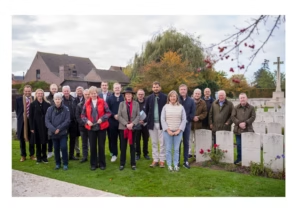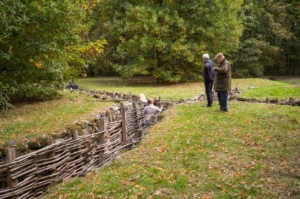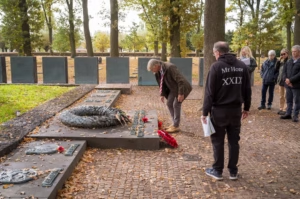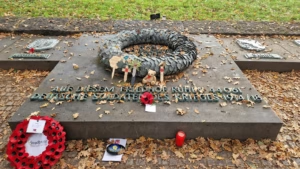2025 is an important milestone for St Paul’s Anglican Church in Monaco.
The church, as it now stands on 22 avenue de Grande Bretagne, was gifted to the Church of England by Prince Louis II in 1925, in recognition of the immense sacrifice made by Great Britain in the First World War. Three members of the community at St Paul’s devised the idea therefore of leading an expeditionary pilgrimage to the Ypres Battlefields to commemorate our centenary.
This trip would allow us to foster even stronger ties amongst our community, honour those whose sacrifice was central to the foundation of our Church and lastly demonstrate St Paul’s continued service to the Principality of Monaco.
Hardly a week had passed when all available spots were taken up through proactive word of mouth promotion. The Ypres Battlefields were selected due to the scope of potential sites to visit and its status as the focal point of First World War remembrance outside of the United Kingdom.
Mark Hone (St Catherine’s College, University of Cambridge) was asked to put together a schedule that would provide an overview of the fighting for Ypres and bring to life the rich history of the Salient. It did not disappoint! The admittedly jam-packed schedule included visits to Messines, Tyne Cot, Bayernwald, The Heuvelland, Essex Farm Cemetery, Sint Sixtus Abbdij, Poperinge, Langemarck, and the Passchendaele Ridge.
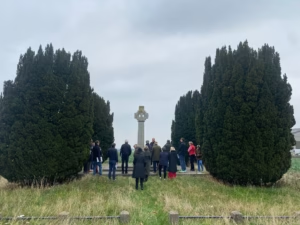
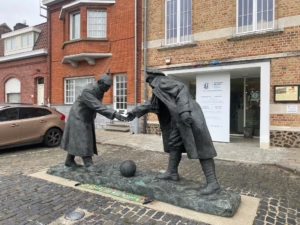

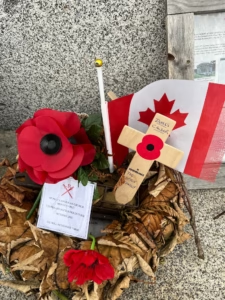
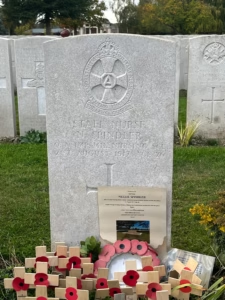
As part of our Remembrance project, wreaths and poppies were laid by members of the tour group throughout the tour. Several monuments and sites were chosen to ensure that as many of the nations represented in our community at Church as possible were visited, including the powerful “Brooding Soldier” memorial to the Canadians, the striking Welsh National Monument, and the Island of Ireland Peace Park at Messines Ridge.
The large Yorkist and Scots contingents on the tour made for two particularly impressive visits; firstly to the Yorkshire Division Monument at Essex Farm (where the celebrated poem “In Flanders’ Fields” was written) and at the Frezenberg Ridge Scottish Memorial, where the pipes were played and a deeply moving personal account of the conflict was given by Ian Petts.
The highlight of the tour came on Wednesday evening at the Menin Gate.
The “Last Post” ceremony was held every evening from 1928 – 1940 by volunteer buglers from the Ypres Volunteer Fire Brigade. The ceremony was suspended during the occupation.
Following the liberation of the town by Polish forces in 1944, the firemen of Ypres retrieved the bugles that they had put away in their attics or hidden under their gardens, and sounded the Last Post for the first time in 4 years, against the sound of gunfire only a few miles away in the outskirts of Langemarck.
These volunteers have conducted the Act of Remembrance at the Menin Gate arches over 34,000 times. For perspective, this is less than half of the number of men and women commemorated at the Menin Gate and at Tyne Cot, and not including those laid to rest elsewhere across the Ypres Salient. It will take another 100 years for each name to have been remembered in this way.
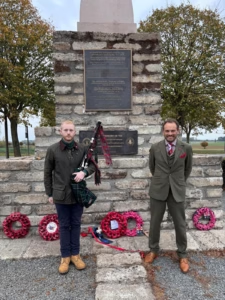
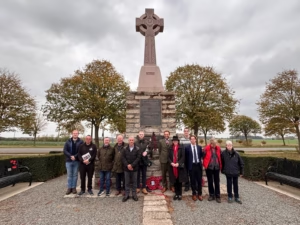
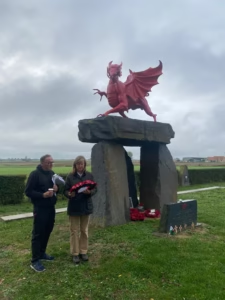


We were honoured to be joined by His Excellency M. Labarrère, Ambassador of Monaco to the Kingdom of Belgium for part of the tour and who laid a wreath at the ceremony on behalf of HSH Prince Albert II. Alongside him were our bearer party who laid wreaths from St Paul’s Anglican Church Monte Carlo, The British Community in Monaco and the RBL Provence-Monaco Branch. The importance of this collaborative effort was not lost on anyone present. Moreover, such was appreciation of our efforts that the Last Post Association has now recorded the entire event and will store the message provided by HSH Prince Albert II in their own centenary archives.
The tour also served as an important occasion in the evolving link between St Paul’s and the Royal British Legion. Founded soon after the construction of St Paul’s, the Nice-Monaco (now Provence-Monaco) branch of the RBL has played a significant role in maintaining the Act of Remembrance within the Principality and all along the Côte d’Azur. Last year, in the presence of HSH Prince Albert II, the old branch standard dating from 1929 was laid up at St Paul’s, with the new standard being dedicated and charged to a member of our own community as the Standard Bearer. Elaine Dempster-Baverstock was part of our group led the branch in supporting this project. Tim Morley carried the standard at the ceremony and was on parade as the first ever representative of the branch at the Menin Gate ceremony in its nearly 100-year history.
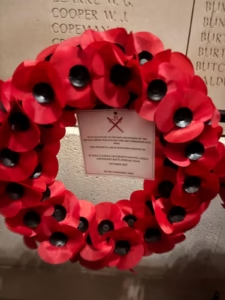

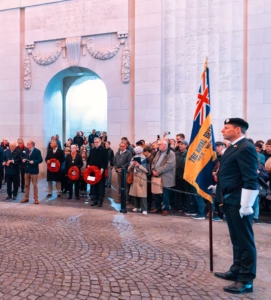

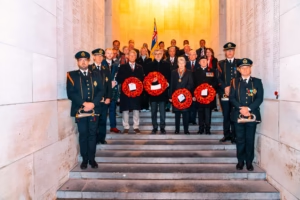

We concluded the tour with a visit to Talbot House (known as “Toc-H”), where our chaplain Hugh led a communion service in the loft chapel. The house was founded by two men of the Royal Army Chaplains Department in 1915 in the town of Poperinge, only 8 miles away from the front lines and just out of range of the German artillery. All clubs, bars, restaurants, rest houses and other such establishments in the town were strictly regulated along lines of class and rank. The ethos of Talbot House was very different. This “every man’s club” was famous for offering a safe haven from the war nearby for all, with officers and men who were encouraged to talk, play or listen to music, read, garden and generally try to find calm amongst the utter carnage only 8 miles away. The motto / order of the house was clear, “Pessimists, way out”. Chaplaincy was a key feature of the British Empire’s expeditionary forces in World War One, with 4,400 chaplains serving and 179 being killed from 1914 to 1918. A total of 736 gallantry awards were awarded to chaplains, including 3 Victoria Crosses. The managers of the museum and guest house today generously provided the group with the original prayer book, chalice and paten used by the Army Padres at Toc-H during the war. It is believed that over 150,000 service men and women went up the steep staircase to the chapel, where it was a privilege for us as the church community to continue the legacy set by Padre “Tubby” Clayton and his fellow chaplains at Talbot House 110 years ago.
A final act of remembrance at Lijssenthoek Military Cemetery marked the end of our expedition.

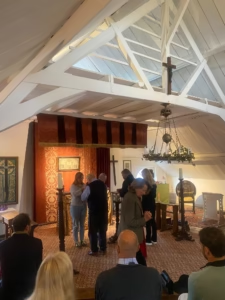
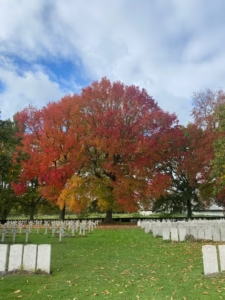

I would like to thank everyone who supported and took part in this thoroughly thought-provoking, moving and fun expedition that leads us all to the start of Remembrance-tide.
Freddie
